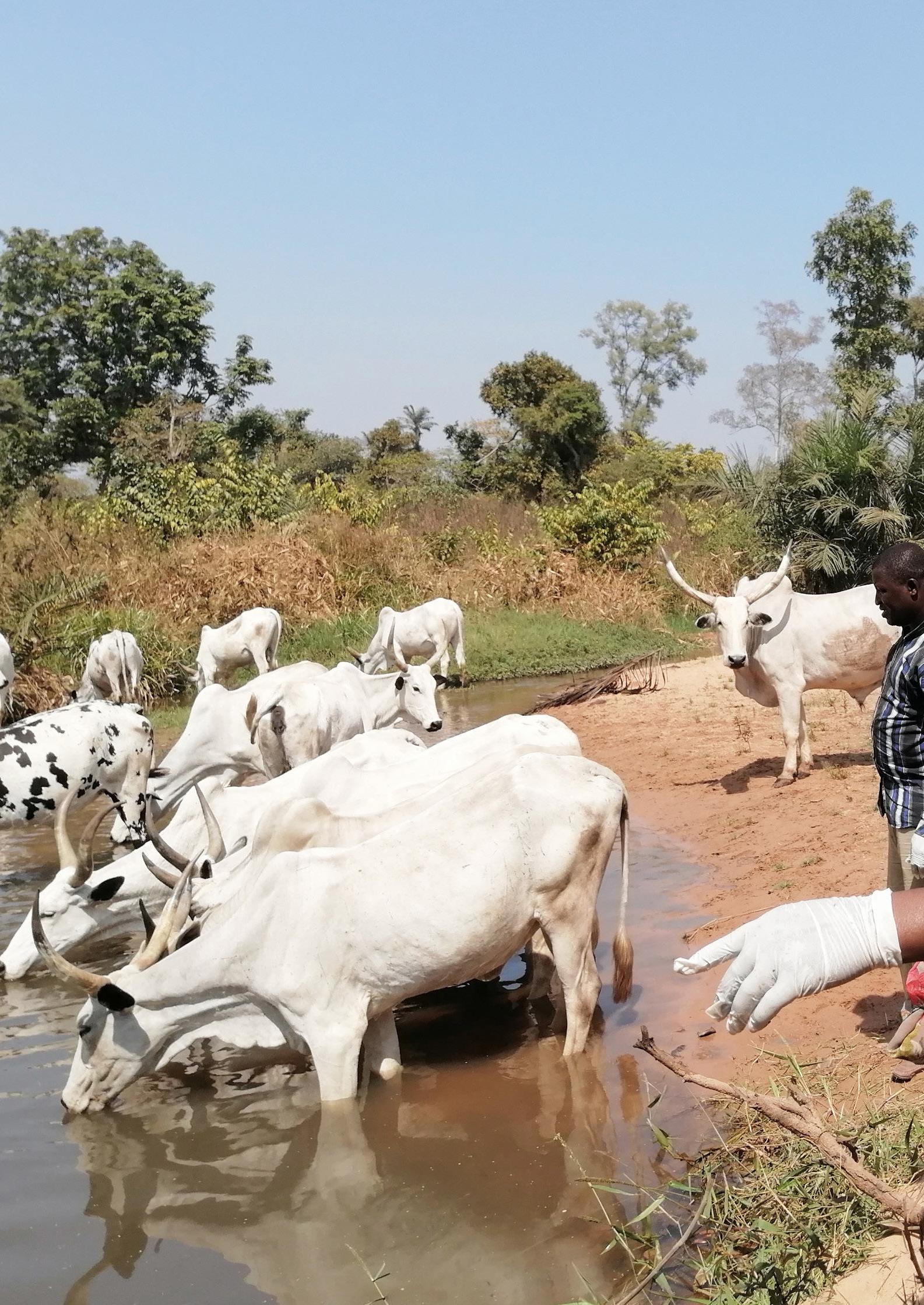
50 minute read
Grants
by IFS
It is a declared objective of IFS to improve production of relevant research by early career scientists in Low- and Lower-Middle-Income Countries (LLMICs). We aim to do this by:
> Providing competitive research grants and capacity-enhancing support > IFS-funded researchers being supported with equipment procurement services > Well-qualified IFS advisors and reviewers evaluating and feeding back to researchers > IFS grantees receiving travel grants to increase international exposure, networking and collaboration, and > IFS alumni associations nurturing and supporting research with early career scientists.
IFS contributes to increased production of research by supporting the research of early career scientists in LLMICs, and by enhancing capacity to conduct research and engage with others in their research.
Mr Athar Hussain, Pakistan, identifying resistance gene classification in cotton.
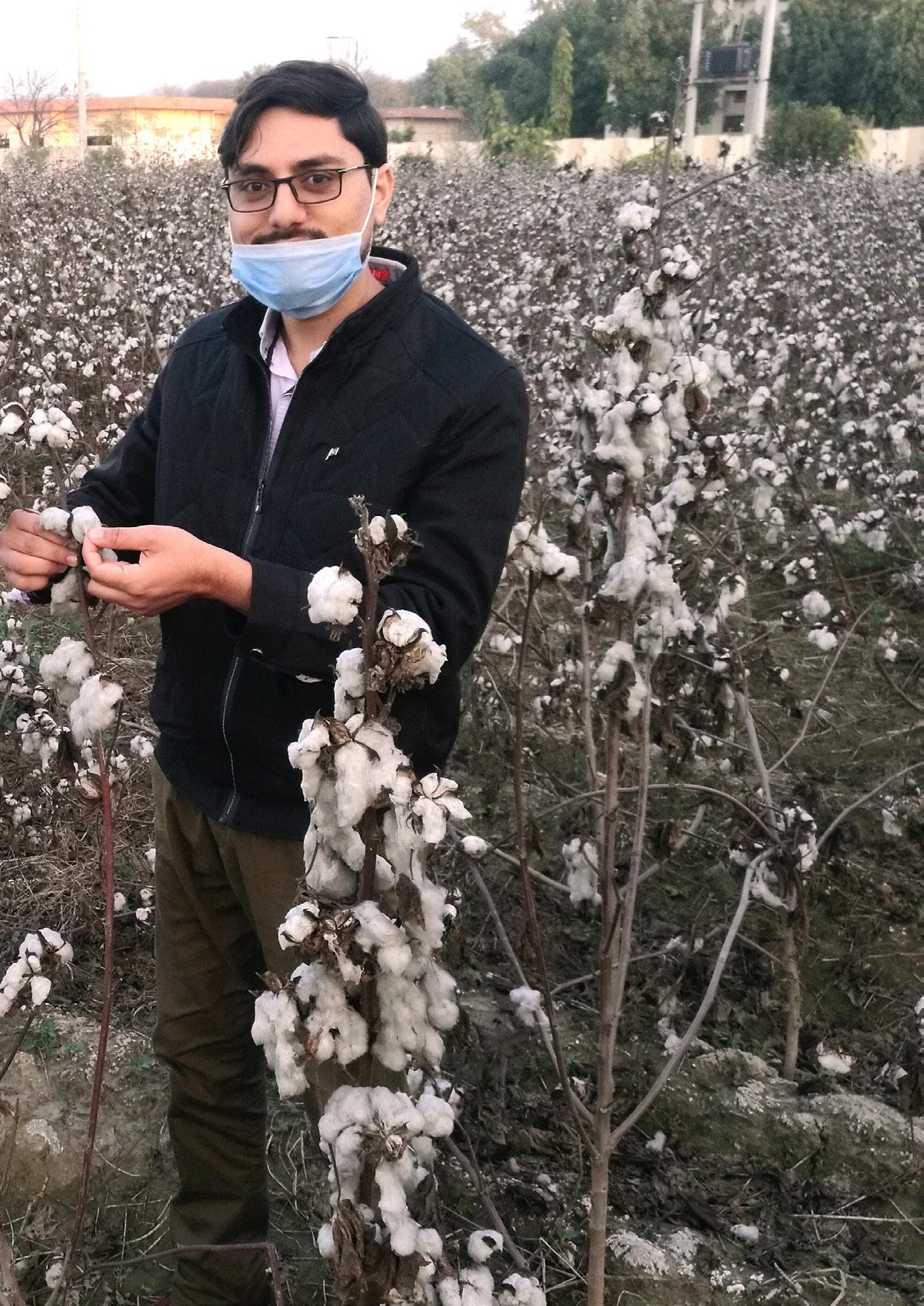
A selection of new individual research grants given in 2020
1. Biological Resources in Terrestrial Systems
Researching Biological Resources in Terrestrial Systems helps us to explore sustainable management of such systems. It is not just focused on exploiting nature for the benefit of humankind, but also doing so in a way which will not jeopardise the well-being of future generations. Natural resources and ecological management are complex and difficult issues to balance with social and economic demands; it is about managing people as much as nature. Some of IFS’s projects that relate to Biological Resources in Terrestrial Systems are highlighted here.
DR GEOFREY GABIRI, UGANDA
Land use and climate change effects on terrestrial carbon stocks in Sezibwa Catchment in Lake Kyoga Basin, Uganda
Significant land use and land cover changes have been reported in the central region of Uganda. The proposed project seeks to i) characterise and quantify historical land use and land cover changes in the Sezibwa Catchment from 1986-2016, and ii) inventory and predict terrestrial carbon stocks and fluxes in vegetation and soils in the catchment. The research objectives build on each other to span both basic and applied scientific endeavours with a view to understanding biogeochemical processes and nutrient (re)cycling in central Uganda and their implications for elevated atmospheric CO2. Historical Landsat images will be interpreted and classified to establish land use and land cover changes. An inventory of terrestrial carbon stocks will be determined and a paired-site sampling scheme will be used to assess C fluxes following land clearing. This will then be integrated in the CENTURY Ecosystem Model to determine the impacts of land change and future climate change on the dynamics of carbon stocks in the catchment.
MR CALVINCE RASHID KAWAWA ABONYO, KENYA
Risk warnings and management countermeasures of alien ornamental plants under climate change in Sub-Saharan Africa: A case study of Nairobi and its environs Invasive alien plants present a danger to natural ecosystems, making their management a priority in the global conservation agenda. One of the costly and most difficult adventures in the management of alien species is eradication once they get established in new ranges. This makes the inhibition of new invasions the most feasible management approach. However, among the leading possible invaders, little attention has been devoted to the risk posed by alien ornamental plants, which are currently being used extensively in public green spaces and private gardens for landscaping and beautification. Even though the prevailing climatic and ecological conditions could have prevented these alien ornamental plants from naturalising, the anticipated environmental and climatic changes could widen their geographic ranges. This study will use the flora of Nairobi and its vicinity as a case study. The findings will help to (1) identify the alien ornamental species with the highest risk of naturalisation that should be considered either for elimination or other restrictive actions, (2) potentially inform the development of a strategic policy framework that can be used by city managers to manage alien ornamental plants with the highest threat, and (3) aid in the realisation of Sustainable Development Goal 15 (Life on Land), that strives to reduce the impact of alien invasive species on terrestrial ecosystems.
MS NAKIGULI FATUMAH, UGANDA
Better off in the wild: A comprehensive captive-breeding and soft-release programme for conservation and sustainable management of the endangered Barbour’s Vlei rat populations in Uganda
Among over 60 Rattus species, Barbour’s Vlei (Otomys barbouri) is the only endemic rat species in Uganda, restricted to their native ecosystem along the slopes of Mount Elgon. Although Otomys barbouri plays critical ecological roles in maintaining a balanced food web as primary consumers of plants and fungi, or as a food resource for larger predators, the species population has declined over the last two decades. The rapid decline is caused by species inbreeding depression coupled with increasing habitat fragmentation, climate change-induced extremities and arable farming activities within the species native ecosystem. Currently, the rats are considered endangered by the International Union for Conservation of Nature. The high vulnerability of the population to the aforementioned ecological threats could soon cause the extinction of this species if no drastic conservation measures are taken. This project seeks to rescue a few individuals of the Barbour’s Vlei population from their threatened environments. They will be multiplied into mass numbers in the laboratory using conventional captivebreeding protocols. To increase the species populations, the captive-bred rats will be released back into different protected habitats in Mount Elgon and Mabira forest ecosystems under soft-release programmes. The project will afterwards
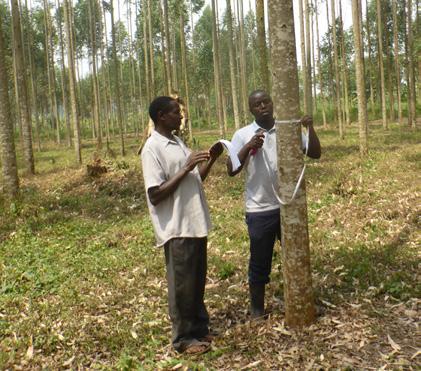
Girth measurement DBH ( Dr Geofrey G measuring with Chairperson of Nyamwoya Village, Mukono, writing).
Mr Calvince Rashid Kawawa Abonyo , Nairobi, identifying different alien ornamental plants. Ms Eleanor Magwaza, Zimbabwe, applying manure.
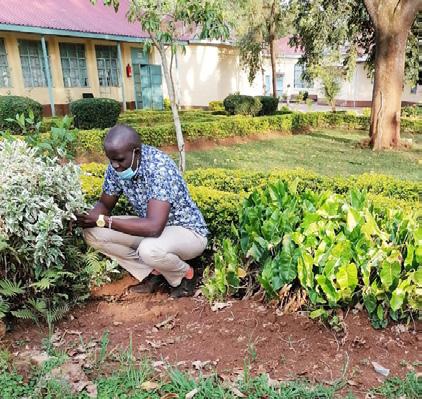
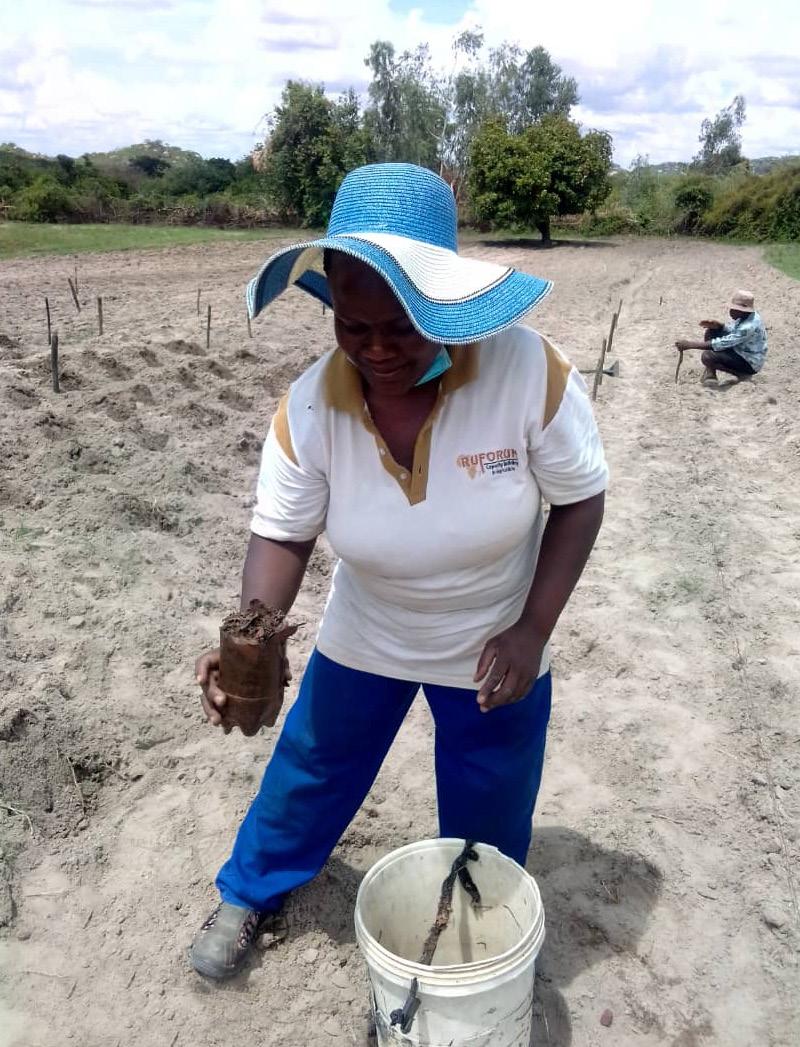
build the capacity of local farming communities in conservation and sustainable management of the wild rat populations.
MS ELEANOR MAGWAZA, ZIMBABWE
Rainwater harvesting and nutrient intensification in maize-legume farming systems in semi-arid Zimbabwe
Agricultural productivity in Zimbabwe is declining mainly due to climate change and inherent poor soil fertility. The situation is worsened by the high cost of fertilisers beyond the reach of many smallholder farmers. In response to these challenges, most farmers are implementing either rainwater harvesting (RWH) or integrated soil fertility management (ISFM). This study seeks to investigate the role of integrating tiedcontour RWH (TC-RWH) technique and ISFM on soil moisture, soil fertility, crop growth and subsequent crop yields in semi-arid areas of Zimbabwe. The study will also determine the economic benefits of integrating TC-RWH, cattle manure and different N-levels of inorganic fertilisers. Data to be collected include soil moisture, chlorophyll, plant height, root collar diameter, crop yields, soil and plant N. The data will be analysed using Genstat 2019 version. We anticipate that integrating RWH and ISFM will improve smallholder farmers’ crop productivity in comparison to where the interventions are implemented separately.
MR HABTAMU DEGEFA DEBELIE, ETHIOPIA
Wetland conversion and greenhouse gas emission in Ethiopia: The case of Cheleleka wetland
Fluxes in carbon and greenhouse gas (GHG) caused by land-use change (LUC) are crucial to understanding drivers of climate change and developing effective mitigation strategies. Cheleleka wetland in southern Ethiopia has been converted to agricultural land since the 1970s. Such conversion is a global phenomenon and is blamed for the release of GHGs at global scale. Nonetheless, information on carbon and GHG emissions from wetland conversion in Ethiopia is limited. The main objectives of the proposed study are to identify drivers of LUC for Cheleleka wetland and quantify the impact of such conversions on soil organic carbon stocks (SOC) and GHG (CO2, N2O and CH4) emissions. The study will show wetland ecosystem response to LUC and in temporal dimensions, and is expected to inform decision-making in wetland management and overall climate change mitigation.
MR WYCLIFFE LUASI, KENYA
Enhancing blast resistance in finger millet through targeted mutagenesis of ethylene response factor transcription factor gene
Finger millet is a staple food for millions of people in East Africa where it is often
grown on marginal land. Blast disease affects the crop at all stages of growth, causing failure in the grain setting and shrivelling the seeds formed, resulting in yield loss. Development of host resistance has shown to be the most effective strategy of controlling blast. Recently, site-directed nucleases have proven to be robust tools for crop improvement. CRISPR/Cas9 technology has emerged as the best genome editing tool in plants due to its efficiency and cost. This study is designed to enhance blast resistance in finger millet varieties through CRISPR/ Cas9-targeted knockout of the plant ethylene responsive factor transcription factor through agrobacteriummediated transformation. The CRISPR/ Cas9 system developed in this project will pave the way for large-scale RNAguided genome editing in finger millet to enhance its breeding to meet growing agriculture demands. Consequently, the management of blast on finger millet will have an enormous impact on Kenya’s food production, allowing the crop to play a significant role in the fight against hunger and malnutrition.
MR ATHAR HUSSAIN, PAKISTAN
Identification, characterisation and functional analysis of resistance genes in cotton
Resistance (R) genes have become the subject of great concern owing to their contribution in plant immunity. R genes are naturally found in the plant genome and translated into R proteins that conceive plant resistance against pathogens through activation of the plant immune system. Several R genes were functionally characterised that display broadspectrum disease resistance in different crops including rice, maize, wheat, barley and potato. However, little is known about the cotton plant, one of the most important crops for production of fibre, a raw material in the textile industry. In this study, we will carry out a genome-wide comparative analysis as well as expression profiling of the resistance gene using high-throughput computing approaches. In addition, based on expression profiling data, further functional analysis will use Virus-Induced Gene Silencing (VIGS) approaches. This study will identify all resistance genes and classify them based on functional domains in three cotton plants. Furthermore, the functional analysis will identify the putative role of R gene under pathogenic stresses. Consequently, this study will help to devise efficient cotton immunity against diseases.
DR BENJAMIN KINGSLEY HARLEY, GHANA
Phytochemical and functional investigations of Ghanaian medicinal plants used in treating human African trypanosomiasis
Human African trypanosomiasis is a disease caused by the parasitic protozoa of the Trypanosoma genus. Despite several efforts at chemotherapeutic interven-
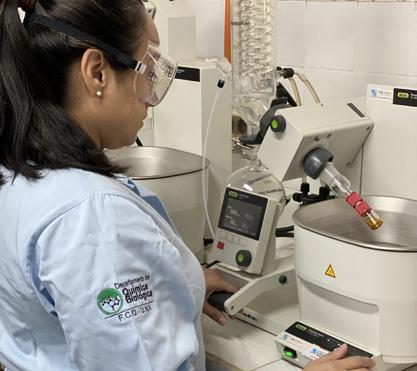
Dr María Eugenia Flores-Giubi preparing extracts from Macrophomina phaseolina culture filtrate, concentration step with rotary evaporator. From left: Dr Benjamin Kingsley Harley (Principal Investigator); and Mr Philip Apraku Tawiah and Mr David Neglo (Laboratory Technologists).
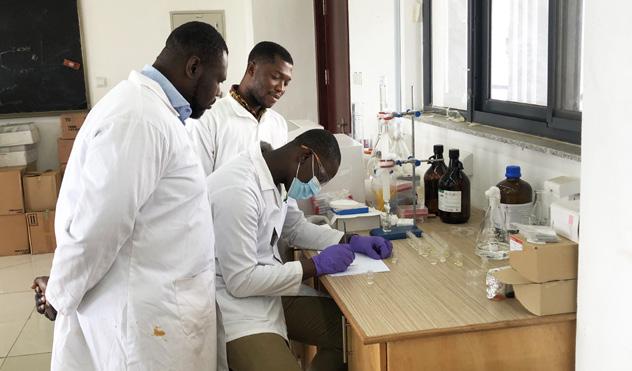
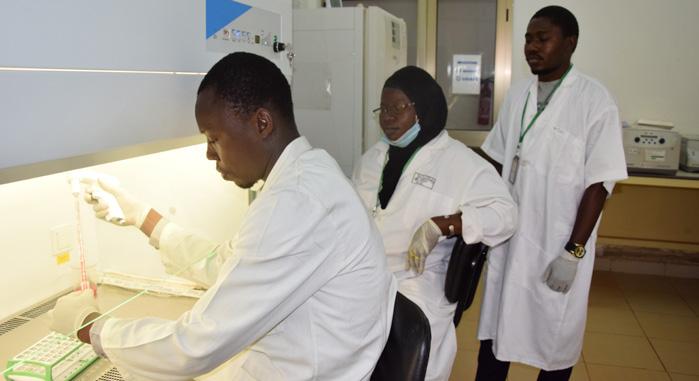
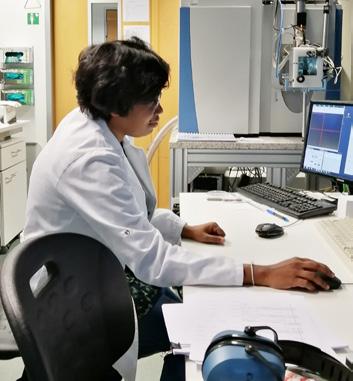
tions, the disease poses serious health and economic concerns to humans and livestock in many Sub-Saharan African countries. Several indigenous Ghanaian medicinal plants have been shown to possess anti-trypanosome properties. However, for a majority of these plants, the active metabolites and the mechanisms of their anti-trypanosomal action remain unknown. This project seeks to isolate the bioactive compounds from six such plants with known anti-trypanosomal activities and determine their in vitro effects and mechanisms against Trypanosoma brucei brucei. The results of this project will unearth lead molecules for drug discovery of novel therapeutic agents in African trypanosomiasis.
DR MAYURI NAPAGODA, SRI LANKA
Green synthesis of metal nanoparticles using invasive plant species in Sri Lanka for the development of effective disinfectants to nosocomial infections
The emergence of multi-drug resistant microorganisms is a global problem that demands the development of alternative antimicrobial remedies from natural sources. Metals and metalloids have been widely employed in medicine for thousands of years owing to their antimicrobial properties. In recent times, metals were found to be even more effective in antimicrobial activity at their nanoscale. The synthesis of metal nanoparticles is conventionally approached via physiochemical methods that utilise expensive and hazardous chemicals. Therefore, this study focuses on the synthesis of metal nanoparticles using non-toxic aqueous extracts of three invasive plant species in Sri Lanka. Thus, the preparation of metal nanoparticles with disinfecting properties by a greener route would be an ecofriendly, cost-effective and low-toxicity approach and also contribute to the management of invasive plant species by utilising potential commercial products.
MR HAROUNA SORE, BURKINA FASO
Synthesis and development of antimalarial transmission blocking natural products, Lophirone E and analogues for the control of malaria Most of the drugs currently used for malaria case management are effective on
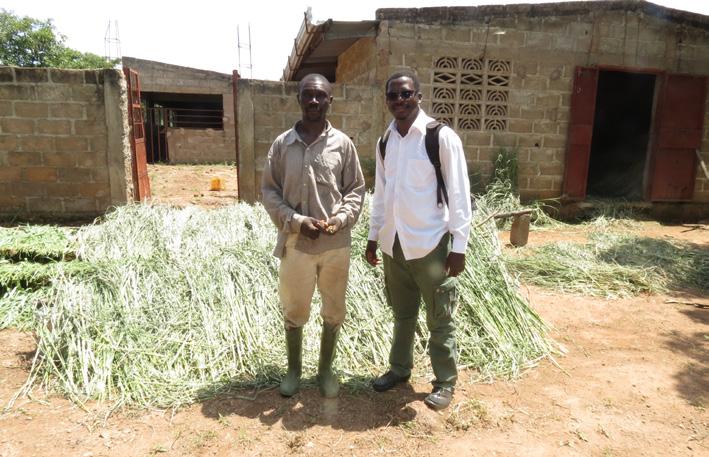
Mr Étienne Sodre (to the right) monitoring the cultivation of fodder crops on the farm of Mr Hema Aboubacary (to the left), in Tarfila (5km from Banfora). The Brachiaria ruziziensis fodder at the back is in the pre-drying phase. It will then continue to dry in the shade for 48 hours before being baled and stored in the hayloft (open door on the right in the photo).
parasite asexual stages but are inactive against the transmissible stages of mature gametocytes. The need to expand the arsenal of transmission-blocking drugs is widely recognised by the scientific community. Bioassay-guided fractionation of the organic extract obtained from stem barks of the African plant Lophira lanceolata has led to the isolation of seven biflavonoids. Among the isolated compounds, the bichalcone lophirone E was identified as a potent gametocytocidal agent with an IC50 value in the nanomolar range against mature gametocytes and negligible cytotoxicity. Lophirone E proved to be about 100 times more active against P. falciparum stage V gametocytes than on asexual blood stages, thus exhibiting a unique stage-specific activity profile. A synthetic approach of lophirone E could allow the preparation of analogues to further improve the potency and optimise the drugability parameters of the compound.
DR MARÍA EUGENIA FLORESGIUBI, PARAGUAY
Evaluation of the effect of Macrophomina phaseolina and its metabolites on the sesame (Sesamum indicum) hormonal response
Charcoal root rot of sesame (Sesamum indicum L.) caused by the phytopathogenic necrotrophic fungus and polyphagous Macrophomina phaseolina (Tassi) Goid is a disease of economic importance that can significantly reduce production yield. Despite being a fungus that affects crops worldwide, the study of the pathogenesis mechanism has been poorly addressed.
DR YOUAN CHARLES TRA BI, COTE D’IVOIRE
Valorisation of pig manure into biogas and determination of microbiological and chemical risks related to the use of digestate as a bio-fertiliser in the peri-urban areas of Abidjan District
Côte d’Ivoire is a country lacking in animal protein. Measures to fill this gap have led to the intensification of the pig sector in the peripheral areas of Abidjan District, accounting for about 90% of Ivorian pig production. This breeding generates a large amount of manure that emits significant amounts of greenhouse gases into the environment. Raw manure is used by market gardeners as a biofertiliser without being granite safe. It is therefore a potential health risk for the environment, animals, consumers and market gardeners. This project therefore aims to enhance the value of pig manure in Abidjan District and to identify associated health hazards. The research involving the livestock, renewable energy and culture sectors will be carried out in collaboration with a consortium of researchers from three laboratories.
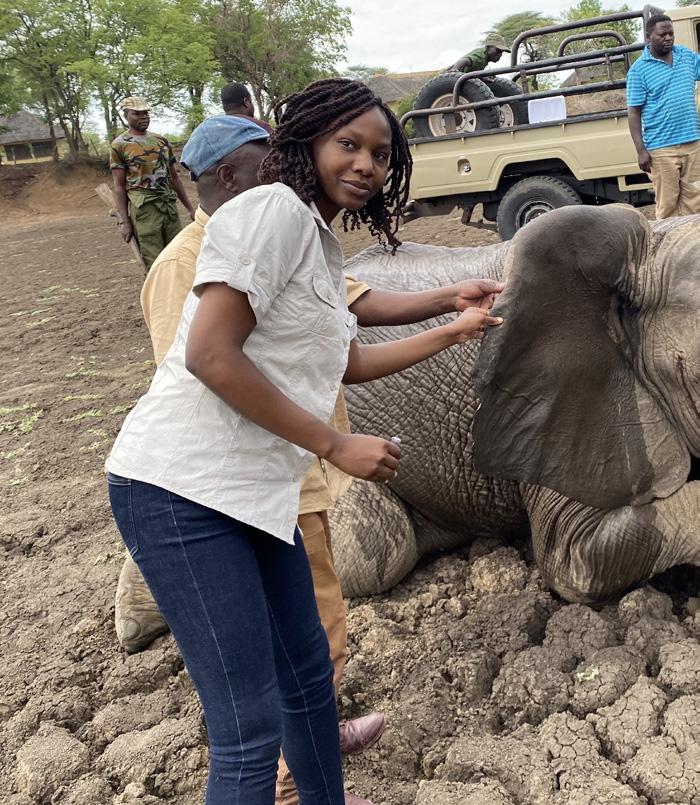
Dr Manyando Simbotwe, Zambia. Sample collection.
MR ÉTIENNE SODRE, BURKINA FASO
Exploration of ways to improve milk production in Banfora’s dairy basin in western Burkina Faso by codesigning with livestock farmers some innovative and agro-ecological feeding options for milking cows
Burkina Faso is struggling to meet its growing demand for milk and dairy products. Despite the diversity of resources, cows’ feeding needs are not met year-round and the almost inevitable forage deficit on almost all dairy farms in the dry season leads to a dramatic drop in milk production. This project addresses this concern by codesigning innovative and agro-ecological options for feeding dairy cows in the Banfora dairy basin. Innovations will be based on the adoption of adapted forage crops in livestock farmers’ crop rotations and the balanced feeding of lactating cows with rations based on cultivated forage and other locally available food resources. In the long term, the project will strengthen the dairy production capacities of farmers by offering them forage varieties and rationing strategies to cover the optimal production needs of dairy cows.
MR MAURICE AHOZONLIN, BENIN
Diversity and resilience of Lagune cattle production systems and development of local institution frameworks for conservation and sustainable use of Lagune breed in southern Benin (West Africa)
The small-sized Lagune cattle population is widely acknowledged to be increasingly replaced by or crossbred with large zebu cattle, compromising the sustainability of cattle production in the region. Furthermore, the geographical distribution of this breed is unknown. While a few previous studies have assessed the productivity of this breed in traditional farming, they did not take into account the potential effects of agroecological variability and of various breeding practices on performance. The in situ conservation of Lagune cattle necessarily involves the creation of a smallholders’ platform for communitybased management. The objectives of the current study are to (i) analyse the diversity and resilience of Lagune cattle population systems; (ii) compare the demographic parameters, productive and reproductive performance of Lagune cattle across various smallholder production systems; (iii) provide an update of the geographical distribution of Lagune cattle breed in South Benin; and (iv) promote the implementation of local institutional frameworks for conservation and sustainable use of the Lagune breed.
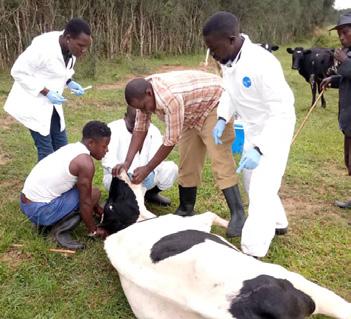
Dr Kerfua (far left) and a district veterinary staff (far right) inspecting a cow’s mouth cavity for any signs of lesions that are classic for foot-and-mouth disease.
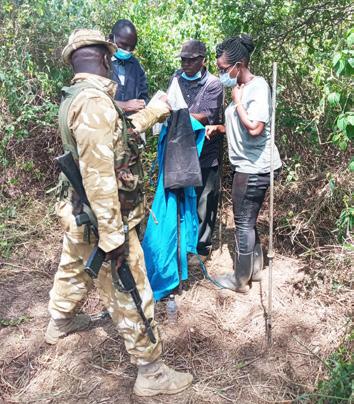
Harvesting a Ngu tsetse fly trap in Turkana County, Kenya. Left to right: Kenya Wildlife Service ranger, Naftali Ogari, Dr Christopher Magut, Dr Winnie Okeyo.
DR MANYANDO SIMBOTWE, ZAMBIA
Serological anthrax surveillance in wild-
life, livestock and humans in the wildlifelivestock interface areas of Zambia
Anthrax is a neglected and re-emerging zoonosis that threatens public health, biodiversity and animal populations. An estimated 63.8 million livestock farmers and 1.1 billion livestock (cattle, sheep, goats, pigs, buffalo) in Africa, Asia and Europe are at risk, and most of these are in remote and poor communities in endemic areas. Although anthrax affects a wide animal host range, it is unknown whether wildlife, livestock and humans are frequently exposed to anthrax infection and whether anthrax exposure and host immune response determine the duration and varying patterns of anthrax outbreaks. This project addresses these questions by developing and evaluating a non-species-specific Bacillus anthracis protective antigen enzyme-linked immunosorbent assay to detect antibodies in humans, livestock and wildlife. Findings from the cross-species comparisons of the seroprevalence of protective antigen antibodies will give novel insights into anthrax exposure patterns and immune responses of various hosts. The study will also offer an inexpensive tool that can be used in resource-limited settings.
DR WINNIE OKEYO, KENYA
Population structure of G. pallidipes in Turkana and West Pokot counties in Kenya
Tsetse flies are the main insect vectors responsible for transmission of the trypanosome parasite, causative agent of Human (HAT) and Animal African Trypanosomiasis (AAT). Both diseases cause economic losses owing to the morbidity and mortality of humans and animals. To date, no vaccines exist against HAT and AAT, while available drugs for HAT treatment are expensive and difficult to administer. Vector control of the diseases has proven viable, as shown by the success on Zanzibar Island, owing to genetic isolation of this population. This has informed the need to understand the dynamics of genetic diversity of G. pallidipes, the most widely-spread tsetse species in Kenya. Previous work concentrated on populations along the KenyaTanzania border. However, G. pallidipes populations in Northern Kenya have not been analysed to create a clear picture of the genetic connectivity of G. pallidipes Kenya-wide. This study will update what is known about the current genetic structure of G. pallidipes in Kenya and will inform the mandated control bodies on the best strategy to employ control efforts for most effective control.
DR DEBORAH RUTH AMULEN, UGANDA
Using molecular profiling of the bee gut microbiome for evidence-based honeybee health and nutritional management in Uganda
Beekeeping offers numerous benefits, such as additional income, food and medicines. However, Ugandan beekeepers have only been able to exploit 1% of their honey production potential. Limited beekeeping husbandry knowledge and honeybee diseases, as well as unexplained honeybee colony declines, are reported as barriers to increased honey production. Hence, the need to understand drivers for bee colony declines in Uganda is critical to boosting bee-related activities. This study aims to document the status of honeybee gut microbes through characterisation of beneficial and pathogenic honeybee microbes, and comparison of abundance level and diversity across areas of highrisk agrochemical use and near-natural environments. This knowledge will provide baseline data on the microbial communities, and potential pathogens found in Ugandan honeybees, with the aim of developing honeybee health and nutritional management plans which beekeepers can adopt.
MS SUSAN DIANA KERFUA, UGANDA
Evaluation of immune response of 6-12 month-old calves to serotype O strain of the foot-and-mouth disease trivalent vaccine used in Uganda
Highly-contagious foot-and-mouth disease (FMD) affects cloven-hooved animals with serious economic consequences for farmers and governments. The Aphthovirus exists in seven serotypes that do not cross-protect. Uganda has had up to six serotypes in circulation with serotype O being the most prevalent. The vaccine currently used has only serotypes O, SAT 1 and SAT 2, while cross-protection between strains within a serotype can be incomplete. The Government of Uganda spends US$ 58,000 to 1,088,820 per annum on vaccination and the country is at stage 2 of the Progressive Control Pathway for FMD (PCP-FMD). However, the efficacy and effectiveness of vaccines used in the country have not been extensively studied, even though antigenic differences between the FMDV strains in the trivalent vaccine have been detected compared to recently circulating Ugandan viruses. This study will characterise the post-vaccination antibody responses of 6-12 month-old calves over an eightmonth period to determine what protection can be expected.
MR AUGUSTINO CHENGULA, TANZANIA
Surveillance and molecular characterisation of Marek’s disease virus (MDV) strains circulating in Tanzania
Marek’s disease (MD) is an oncogenic viral disease of poultry responsible for economic loss due to both mortality and depressed performance. The evolution of Marek’s disease virus (MDV) has been reported at alarming rates in poultry houses, overcoming even the vaccinated poultry and leading to disease. The aim of this research is to improve the control of MD in Tanzania through proper selection of vaccine matching to the circulating MDV strains. This will be accomplished by detecting and characterising all the MDV virulent strains circulating in the country by using molecular techniques and comparing them with the vaccine currently in use. This information will be useful for vaccine manufacturers and users.
A selection of new individual research grants given in 2020
2. Water and Aquatic Resources
According to the World Bank, 2.8 billion people live in areas of high water stress, which takes many forms. At least 1.2 billion people do not have access to safe water, and pollution of water affects not just people but whole biological communities. Some of IFS’s projects that relate to good water management are highlighted here, as well as projects related to sustainable use of natural aquatic resources.
MS NOOR UL AIN, PAKISTAN
Fabrication of novel plant-based copolymers and their scrutinisation as xenobiotic remediators for pharmaceutical and textile wastewater effluents
Industrial wastewater effluents are enriched with excess levels of xenobiotic compounds that in turn cause serious environmental issues if disposed of untreated. In Pakistan, the situation is alarming, with a rapid decline in water quality. There is a need to devise economical and effective wastewater treatment strategies that could be implemented for removal of xenobiotics from pollutioncausing pharmaceutical and textile effluents before being discharged in water bodies.
DR CHUKWUEBUKA EMMANUEL UMEYOR, NIGERIA
Development and quality evaluations of nanoemulsions of Moringa oleifera seed extracts for water purification
Clean water is an essential human daily need for drinking, cooking and sanitation. The availability and supply of potable water remains elusive, especially in Sub-Saharan Africa, where life-threatening health risks due to consumption of contaminated water kill about 485,000 people annually. Since chemical disinfection of water is expensive and is associated with substantial systemic toxicity and undesirable effects, the use of inexpensive, safe and readily available seed extracts of Moringa oleifera (known for its high content of hydrophilic cationic coagulant protein) for water purification becomes exciting. Therefore, the aim of this project is to develop nanoemulsions of seed extracts of M. oleifera and carry out quality evaluations for their use in water purification. It is expected that stable nanoemulsions of M. oleifera seed extracts with desirable physicochemical properties will be formulated, and purified water that meets WHO standards will be obtained.
DR LEVY MICHAEL OTWOMA, KENYA
To assess the effect of overfishing on the genetic diversity of commercially important reef fishes in Kenya
Despite increasing evidence that the effects of overfishing can contribute to shifts in species diversity and abundance, few empirical studies have documented the consequences of overfishing on genetic diversity of marine species. This is risky, because the effective population of marine fishes can be much lower than their census abundance. Differences in exploitation rates of wild marine fishes provide an opportunity for comparing genetic diversity of overexploited and underexploited species that are closely related. Because genetic diversity is expected to be similar in such species, close relatives that have not been overexploited can provide a baseline for historical genetic diversity. In this project, we use microsatellites to compare the genetic diversity and connectivity of overexploited reef species (Siganus sutor and Lethrinus lentjan) with their underexploited congeners (Siganus rivulatus and Lethrinus harak). Overall, this study seeks to provide compelling evidence by showing the effects of overfishing on genetic diversity of commercially important reef fish species.
DR MOUSSA DJAOUDA, CAMEROON
Monitoring water sources for environmental reservoirs of Vibrio cholerae with its O1 serogroup and toxigenic subpopulations in the cholera endemic areas of north Cameroon
This project will investigate water sources in the cholera endemic areas of north Cameroon for contamination with Vibrio cholerae O1 with pathogenic potential, to highlight their role in disease transmission. The recurrent cholera outbreaks in north Cameroon point to the existence of hotspot cholera potential reservoirs, including polluted surface water and groundwater. The question is how the persistence of pathogenic V. cholerae O1 in the water sources determines the cholera outbreaks in the region. In a prior research project, we showed that some well and stream water sources of the region are positive for culturable V. cholerae. All the collected isolates were V. cholerae non-O1. However, it was found that non-O1 environmental strains are both attached to particles or hosts as well as free living and readily culturable, while pandemic-related V. cholerae O1 are mostly as particle/host-associated
Ms Noor Ul Ain, Pakistan. Adsorption kinetics of biopolymer-treated wastewater by UV-Visible Spectrophotometer. Dr Ram Devi Tachamo Shah processing benthic samples to reduce mineral substrate and large organic matter at a site in the Marshyangdi River, Western Nepal, Central Himalaya.
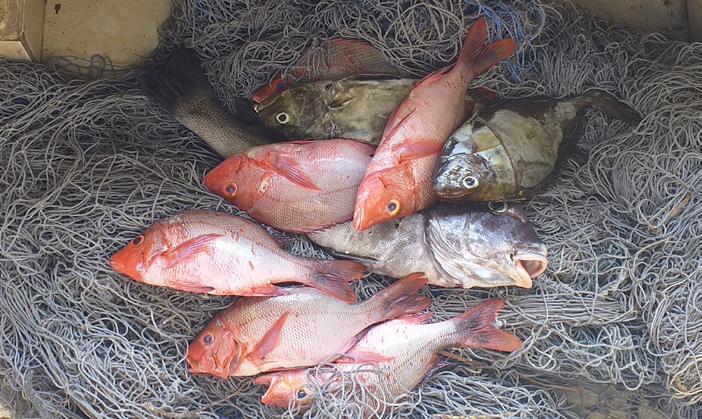
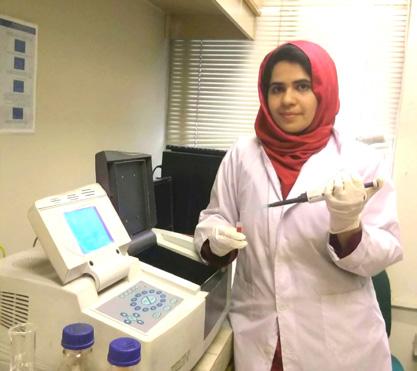
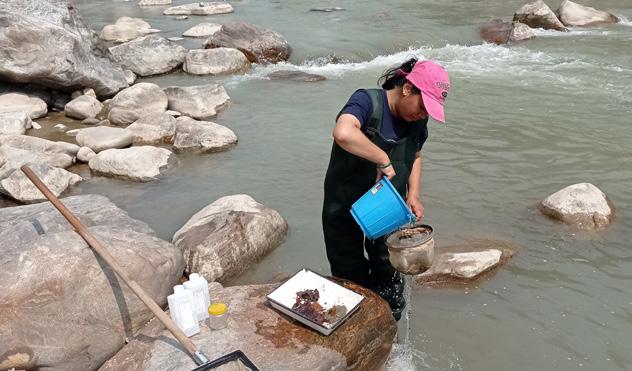
Dr Levy Michael Otwoma, Kenya. A fisherman’s catch composed of the study target species Lethrinus lentjan and Lethrinus harrak.
and in a non-culturable state. Since the epidemiology of cholera is closely linked to the ecology of V. cholerae in the environment, an understanding of the conditions that support its persistence and multiplication is crucial for public health protection. The urgency of this project is that at this particular moment the influx of Nigerian refugees is affecting the management of water resources and this allows us to point out environmental niches of toxigenic V. cholerae O1 in real time to better prevent cholera outbreaks.
DR DJIDJOOH MATHIEU MAURICE AHOUANSOU, BENIN
Ecohydrological modelling for the understanding of pollutants transfer dynamics in Hlan River Basin, Southern Benin
Increased agricultural and urban development has increased chemical pollutants and sediment fluxes in many watersheds worldwide. High pollutant concentrations could negatively affect water quality in aquatic systems, adversely affecting ecosystems through eutrophication, acidification and ground water contamination, all of which subsequently lead to a loss of biodiversity. In Hlan River Basin, deforestation due to agricultural activities and increasing demand for settlement in the upper Hlan catchment were observed as threats to water quality in the Hlan River system. Furthermore, existing food industries in the catchment are polluted by discharging wastewater. There is an urgent need to identify the major pollutants and their sources, and to analyse the pollutant and contaminant behaviour in the Hlan River Basin with regards to its hydrological processes for better natural resources conservation. The main objective of this research is to understand the dynamics of water quality parameters using in situ measurement and a semi-distributed modelling approach, with a particular accent on the filter role of wetland where anthropogenic activities are important. This project will study the role of hydrological processes in the transport of pollutants and sediment and also the filter role played by wetlands and swamp forest.
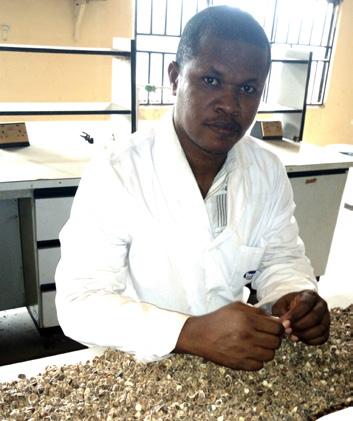
Dr Chukwuebuka Emmanuel Umeyor in his institution’s Natural Products Laboratory preparing dried Moringa oleifera seeds for extraction of oil and protein.
DR RAM DEVI TACHAMO SHAH, NEPAL
Development of assessment tool for evaluating the impacts of hydropower dams on aquatic biodiversity Today, river ecosystems are largely fragmented due to dams or diversion schemes to supply water for drinking, irrigation, industrial uses and energy production. Over three-quarters of large global rivers are modified and nearly no free-flowing rivers remain in developed nations. With abundant water resources, Nepal is not an exception, where the government has prioritised water resources development as key for economic growth. As a result, many rivers are either dammed or in the process of being dammed, maximising human benefits and altering flow regimes and river characteristics that imperil aquatic habitats

Analysing parameters in-situ in the field (water temperature, pH, DO, salinity) and collecting water samples for lab analysis. Left to right: Le Huu Hiep, Dr Luu Duc Dien, Nguyen Van Ba (farmer). Dr Emmanuel Delwin Abarike and assistant inspecting fish to be used for stocking in culture tanks.
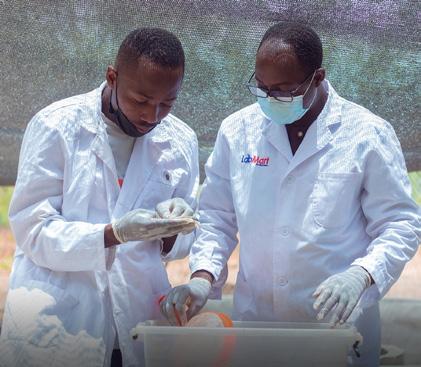
Dr Ngoc Do Queyen Chau and student discussing conditions for making aerogels, with freeze-drying machine in background.
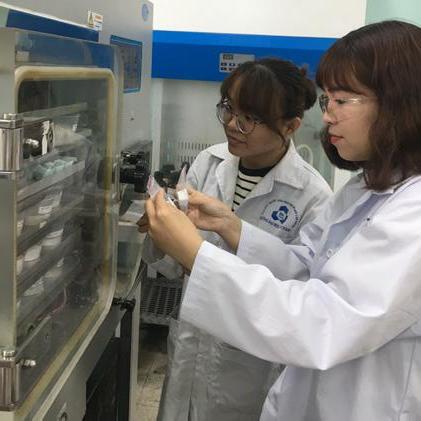
and biodiversity, with potentially irreversible and unquantifiable costs. Therefore, timely interventions to preserve the aquatic biodiversity and to maintain river health are imperative. In this regard, a bioassessment tool can evaluate the impacts of infrastructure on river health and aquatic biodiversity. Among others, macroinvertebrates are considered as good bioindicators because their abundance and diversity change with the intensity and frequency of impacts on river systems. The majority of sensitive macroinvertebrates are reophiles whose assemblages depend on fast flowing water. The developed method will help water developers and conservationists ensure the ecological integrity of river ecosystems. This tool will be instrumental for policy formulation to achieve sustainable water resources management in Nepal.
DR CYRUS RUMISHA, TANZANIA
Genetic analysis to improve management and conservation of the endangered East African wedgefishes and their habitat
Due to rapid human population growth in recent decades, the price and demand for fish in East Africa have increased dramatically. This has led to increased pressure on fishery resources and increased incidences of illegal fishing, overfishing and habitat degradation. Hence, fish stocks have declined and the important species are disappearing. Since they grow slowly, produce few young, and their fins hold the highest value of all fins in international markets, the populations of the whitespotted wedgefish (Rhynchobatus djiddensis) and the bottlenose wedgefish (Rhynchobatus australiae) have declined by more than 80% in the last three decades. Although they should not be traded internationally without CITES permits, processed products of these fish are still supplied illegally to international markets since they cannot be easily identified by law enforcement due to the lack of key morphological identification features. Also, East African countries are increasing the number of marine protected areas (MPAs) in areas occupied by these fish but the stock structure and the patterns of genetic connectivity among the MPAs are largely unknown. Hence, it is not known whether these fish should be managed as a single randomly-mated stock or if there are genetically isolated stocks that should be treated as separate management units. This project will use molecular markers to expose the illicit trade networks and identify appropriate management units and the priority areas for fish sanctuaries.
MR ROMUALD HOUNYEME, BENIN
Modelling by bayesian networks of the ecological resilience of a tropical hydrosystem with multifactorial vulnerabilities: The case of Lake Nokoué
Much current research on continental hydrosystems refers to the concept of the stability of the functioning of aquatic ecosystems and their resilience. This study will infer the structure of a Bayesian network whose parameters are the proven functional diversity needed to provide information on the processes operating within the ecosystems and the synergistic interaction of cumulative impacts of anthropogenic pressures. The different nodes of this network will be represented by multiple variables perceptible to various types of anthropogenic degradation, testifying to the diversity and ecological functioning of the environment. The aim of the research is to associate bioinformatics with ecology to better understand the functioning of Lake Nokoué, a lake ecosystem in a highly disturbed tropical zone. It will include i) studying the dynamics of functional diversity of fish and macrobenthic communities and their potential roles in the functional stability of the studied hydrosystem; ii) highlighting the effects of cumulative impacts of pressures on resilience; and (iii) modeling of ecological resilience capacity, centered on various functional interactions of communities in relation to the cumulative set of different pressures described. Beyond the important scientific, environmental and societal issues involved in this project, it will provide future managers of aquatic and halieutic resources with a rational management tool for the lake.
MR WORKIYIE WORIE ASSEFA, ETHIOPIA
Development of macroinvertebrate-based multimetric wetland index of biotic integrity for assessing wetland ecosystems health in Upper Blue Nile Basin (West Gojjam), Northwest Ethiopia
Little is known about aquatic macroinvertebrate assemblage in the wetlands of the Upper Blue Nile Basin despite their important ecology services and value as ecosystem heath indicators. The sustainability of wetlands will not be ensured unless continuous monitoring is conducted using fast, integrative and cost-effective ecological indicators such as macroinvertebrates. Therefore, the objective of the study is to develop a multimetric wetland index of biotic integrity (W-IBI) and to investigate the spatial and temporal dynamics of macroinvertebrate assemblages. The outputs of this study will contribute to the sustainable management of wetland ecosystems, and to the development of taxonomic keys and guides for macroinvertebrate identification in Ethiopia.
DR LUU DUC DIEN, VIETNAM
The interaction between integrated riceshrimp ponds with adjacent waterways in Bac Lieu Province, Vietnam
Rice-shrimp farming in Vietnam’s Mekong Delta is under rapid development. However, there are serious warnings about organic pollution in some high-density culture areas which may threaten sustainable development of rice-shrimp farming and normal functioning of the river. Therefore, it is important to study the type, level and origin of organic pollution from integrated rice-shrimp ponds (IRSPs) to maintain sustainable development of rice-shrimp farming, since the IRSPs themselves are dependent on the health of the Mekong River. This project aims to assess (i) the impact of waste discharge from IRSPs on the health of the water environment in Bac Lieu Province, and (ii) the dependency of rice-shrimp farming practices on adjacent waterway quality. This research will help to understand more clearly the nature of organic pollution in the IRSPs in Bac Lieu Province so that the responsible agencies will be able to assess organic pollution at incipient levels, allowing for timely action.
DR EMMANUEL DELWIN ABARIKE, GHANA
Contribution of a mixture of extracts of guava, bitter and pawpaw leaves in improving growth, hematology, immunity and resistance to Streptococcus agalactiae outbreaks in Nile tilapia (Oreochromis niloticus)
The production of Nile tilapia (Oreochromis niloticus) in recent times has suffered losses from pathogenic infection (particularly Streptococcus agalactiae), reported to cause up to 70% mortality in fish stocks. However, with associated undesirable effects of antibiotics and hormonal use in controlling diseases in fish, herbs such as guava leaves (GL), pawpaw leaves (PL), and bitter leaves (BL) have been reported to be suitable alternatives to combating pathogenic diseases. Although studies have been conducted on GL, Pl and BL in fish culture, still necessary are studies geared towards determining (1) the possibility of synergistic effects using herbal mixtures, (2) the influence of herbs on physiology and histological parameters, and (3) the optimal dose of herbal mixtures for use in fish culture. It is hoped that the findings of this study will be communicated to fish farmers, and fish feed and fish drug producers, to help promote research and the application of these herbs to improve tilapia production. It is expected that the mechanism of action and optimal dose of a mixture of GL, BL and PL in promoting growth, hematology, immune function and disease resistance will be ascertained.
DR NGOC DO QUYEN CHAU, VIETNAM
Advanced fabrication of aerogel from graphene oxide and cellulose for wastewater treatment
Heavy metals are known to be highly toxic and non-biodegradable, and to cause organ damage and cancer in humans. There is an urgent need to eliminate heavy metals from contaminated water sources before they are released into the environment. In addition, with the growth of the petroleum industry and the necessity of marine transportation, oil spills have become a greater threat to the water ecosystem. Moreover, organic dyes are also pollutants in wastewater due to the development of the textile and garment industry in recent years. Therefore, our research focuses on the fabrication of aerogel from graphene oxide, a suitable material for water treatment, in combination with cellulosebased materials from agricultural waste. The result of this research will contribute significantly to the treatment of oil, organic dye and heavy metal ions that contaminate water in Vietnam.
DR HO HUU LOC, VIETNAM
Evaluating and mapping of ecosystem services associated with sustainable urban drainage systems (SUDS): A case study in Ho Chi Minh City, Vietnam
Ho Chi Minh City (HCMC) is frequently prone to flood risks emerging from both natural factors such as high tides and heavy rainfall, and human activities such as urbanisation leading to the degradation of drainage capacity. The city has seen an increase in its impervious surface area in the central districts, dramatically reducing the surface infiltration capacity. The risks are expected to be exacerbated by climate change. Besides mega-investments in flood control infrastructure, HCMC has started to explore SUDS, the focus of this project. In addition to flood mitigation, SUDS consider environmental, social and economic pillars in the design process, thus simultaneously achieving multiple benefits alongside flood mitigation. These include removing pollutants from runoff, cleansing the ambient air, reducing urban heat island effects, enhancing aesthetics, and even supporting urban wildlife habitat and biodiversity. SUDS benefits are harder to measure and associate with the primary function of flood reduction. This study will develop a framework to evaluate SUDS benefits using the ecosystem services approach, which is an established method to measure nature-derived human benefits using a mixed-method approach. The project outcomes will benefit HCMC residents by acknowledging the benefits of SUDS while providing valuable research experience for those involved.
MS FLORA CHIRIKONA, KENYA
Adsorption of perfluoroalkly acids from wastewater onto water hyacinth-based nanofibers: Thermodynamics, kinetics, isotherms and mechanisms
Conventional wastewater treatment technologies have been shown to be inefficient in removing toxic perfluoroalkly acids (PFAAs). This study will investigate the efficiency of water hyacinth-based TiO2 and MgO impregnated nanofibres in adsorption of perfluoroalkly acids from wastewater and to study the thermodynamics, kinetics, isotherms and mechanisms. The study will further compare adsorption abilities of water hyacinth nanofibre adsorbents to commercial powdered activated carbon and also determine levels of PFAAs in Nairobi River water basin. The findings will inform and provide alternative green technologies for sustainable management of toxic PFAAs. The utilisation of water hyacinth will help in sustainability of surface water resources as well as to control the weed.
DR NGÔ ANH DÀO HÔ, VIETNAM
Study on removal of Natural Organic Matter (NOM) from surface water by
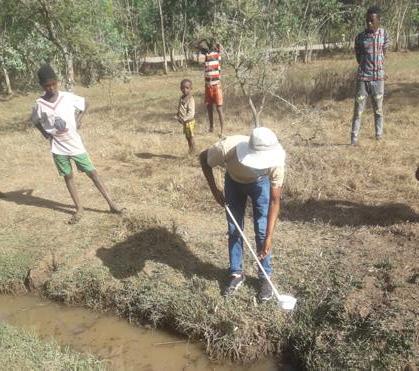
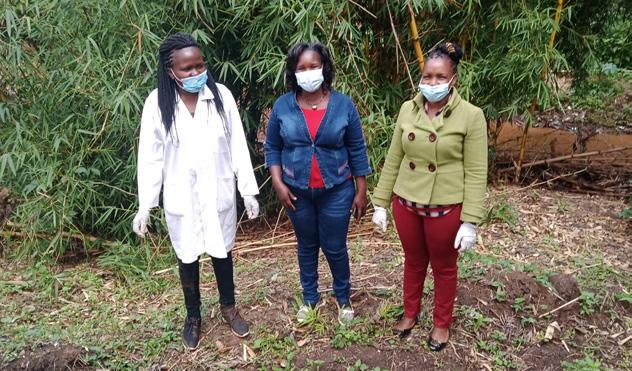
Mr Dawit Hawaria, Ethiopia, conducting larval survey. Ms Flora Chirikona, Dr Kimosop and Emily after sample collection in Nairobi river.
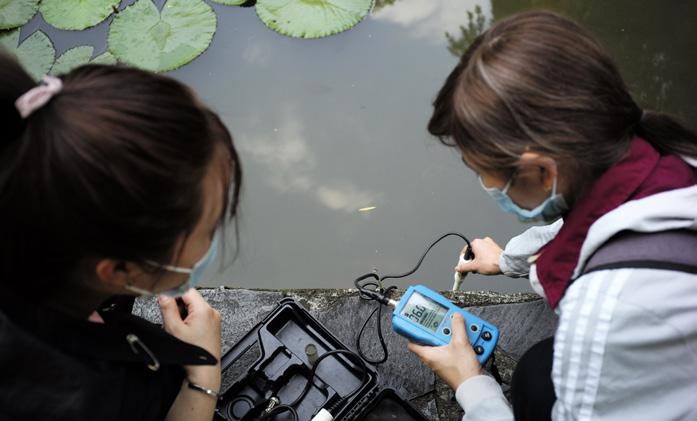

using coagulation and flocculation to mitigate the formation of chlorine disinfection by-products: A case study of Thu Duc Water Treatment Plant, Ho Chi Minh City, Vietnam
The reaction between natural organic matter (NOM) in water and chlorine during disinfection poses a threat to form trihalomethanes, which are commonly classified as a carcinogenic disinfection by-product (DBP). In Vietnam, most water treatment plants use traditional technologies for the process and the issue of DBPs has not been considered. Thus, this study will investigate the removal of NOM from surface water collected from the raw water intake station of Thu Duc Water Treatment Plant in Ho Chi Minh City by using Jar-test experiments as a simulation of coagulation and flocculation. A detailed comparison in terms of technical and cost aspects of three coagulants is expected to result, useful as data for local authorities in the control and assessment of water quality before distribution into the water supply network.
MR DAWIT HAWARIA, ETHIOPIA
The impacts of water source development on the malaria vector bionomics and diseases transmission, Ethiopia
Irrigated agriculture is key to increasing agricultural productivity and ensuring food security in Sub-Saharan Africa. Construction of dams and irrigated farms have been widely recognised as solutions to promoting food security and alleviating poverty. In Ethiopia, a number of dams and irrigated farms have been developed in the past decade, with many under construction and more being planned. Such development projects are anticipated to cause major changes in the ecology of malaria vectors and disease epidemiology. However, how the vector ecology changes alter disease transmission dynamics has not been investigated for many newly-established irrigation developments. Ideally, what is needed are new intervention approaches that can effectively suppress malaria transmission while simultaneously increasing agricultural productivity. Thus, the objective of this project is to examine the impact of environmental modifications from water source development projects on vector ecology and malaria transmission at the newly-established Gidabo irrigation scheme in Ethiopia. The project will provide important information on the impact of environmental modifications on malaria vector species composition, population dynamics, vectorial capacity, and quantify transmission intensity at the study site. The study results will provide baseline information for the development of improved disease intervention approaches while implementing development projects that ensure food security.
DR ETEFA GUYASSA DINSSA, ETHIOPIA
Interaction between exclosure and hydrological processes in dryland mountainous environments: Perspectives for irrigation stormwater runoff on reforested areas, northern Ethiopia
Recovery of degraded land through the establishment of exclosures (areas set aside from human and livestock interference to restore natural resources and ecological restoration) has become a key process in the improvement of forest ecosystems. Despite the extensive period of their establishment, vegetation growth in exclosures is constrained in northern Ethiopia. In addition, limited investigations are available on their linkages with catchment hydrological processes. Hence, this project will 1) assess exclosures that are suitable for spate irrigation with stormwater runoff diverted from streams, 2) create relationships between exclosure characteristics and hydrological processes, and 3) examine net primary productivity of exclosures with different characteristics and stormwater management. Data will be produced to understand the dynamic interaction between restoration and catchment hydrology, and the effects of management on the productivity of exclosures in northern Ethiopia and in dryland environments in general.
A selection of new individual research grants given in 2020
Food security exists when people have access at all times to sufficient, nutritious food in order to to lead active and healthy lives. There are many angles to food security – food safety, nutrition, and simply securing entitlement to food. Below are some projects from the IFS research area on Food Security, Dietary Diversity and Healthy Livelihoods.
DR MARIAMA NGOM, SENEGAL
Restoration of the fertility of degraded arable lands in Senegal by integrating Casuarinaceae nitrogen-fixing trees into agricultural crops
Land degradation is a global environmental issue with devastating consequences for food production and human wellbeing. Senegal faces a serious problem of arable land degradation due, among others, to long periods of monoculture with no fallow periods and strong anthropogenic pressure on natural resources. Given that arable land represents only 19% of the national territory and that the Senegalese population has almost tripled in 50 years, there is a need to restore the fertility of these degraded soils and ensure livelihood security in rural areas. Agroforestry practices in which nitrogen-fixing trees are integrated into agricultural crops are one of the sustainable strategies to restore the fertility of degraded land. Fast-growing nitrogen-fixing trees belonging to the Casuarinaceae family are pioneer plants, able to colonise disturbed soils and increase their fertility, thanks to their capacity to establish symbiotic associations both with mycorrhisal fungi (arbuscular and ectomycorrhizal) and the nitrogen-fixing bacteria Frankia. In Senegal, Casuarinaceae are mainly used for sand dune stabilisation and the rehabilitation of salt-degraded land. This project will (i) study the effect of Casuarinaceae-crop intercropping on the growth and productivity of associated agricultural crops, (ii) evaluate the impact of intercropping on the physicochemical properties and microbiome of the soil, and (iii) assess the effect of intercropping on the biological quality of the soil using nematodes as bio-indicators.
MS ONJA HASINAHARY RATSIATOSIKA, MADAGASCAR
Intensification of soil ecological functions to enhance the resilience of rainfed rice cropping systems to rainfall reduction
Agroecology is based on the intensification of ecological processes in agrosystems. In tropical regions where smallholder farmers develop their crops on fragile and poor soils, with low available chemical inputs and under climate change, agroecological transition is particularly important. Agroecological practices optimising functional biodiversity aboveground are widely recognised as beneficial to mitigate climate change, whereas little information is available about belowground (soil) biodiversity and functions. However, soil organisms have high potential to promote multiple ecological functions, enhancing ecosystem services and resistance, and resilience of agrosystems to agricultural shocks. In the context of climate change predicting a rainfall reduction in most tropical regions, it appears crucial to optimise soil ecological functions to reintegrate sustainability and to develop crop resilience in rainfed agricultural systems. Recently, an on-going research project allowed testing in real field conditions of the rehabilitation of soil ecological functions in rice rainfed systems through practices codesigned by farmers and scientists. Besides measuring agronomic and ecological performances of those practices, our aim is also to measure their resilience to climatic stress. Thus, we propose to develop a rainfall exclusion system to measure the resilience of soil function restoration practices to climatic stress to identify best practices to suggest to farmers.
MS BAL KUMARI OLIYA, NEPAL
Evaluation of genetic diversity using molecular and phytochemical marker, anticancer activity and in vitro propagation of Paris polyphylla Smith in Nepal
Paris polyphylla Smith is a well-known herbal medicine with proven therapeutic potential and listed as vulnerable by the IUCN. The rhizome of this herb is widely used in traditional medicine to treat fever, headache, back pain and bleeding, and for poison neutralisation. Steroidal saponins are the main chemical constituents of this plant’s rhizome, which account for more than 80% of the total compounds. Steroidal saponins isolated from this herb showed structural diversities with proven bioactivities including antitumor, hemostatic, immunotropic, anti-inflammatory and analgesic properties. Since there exists variability in the active constituents of the same plants growing under different environmental conditions, understanding genetic di-
Dr Ruth Lindizyani Mfune doing serology analysis (screening serum for brucellosis using the Rose bengal test). Advocacy visit to a study site (Community head seated, three other community leaders sitting by wall, Dr Ajakaye Remilekun (middle with lab coat) with two field assistants.
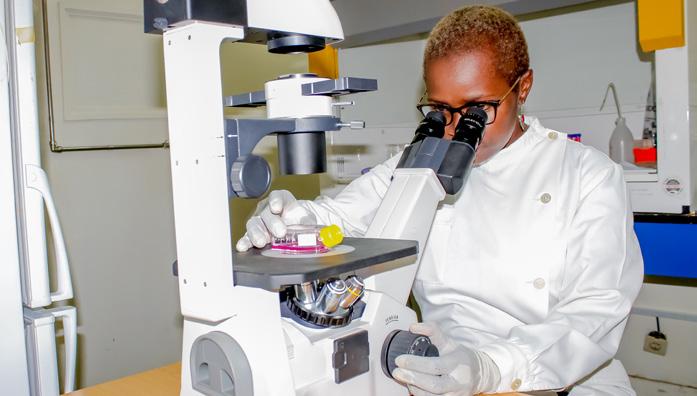
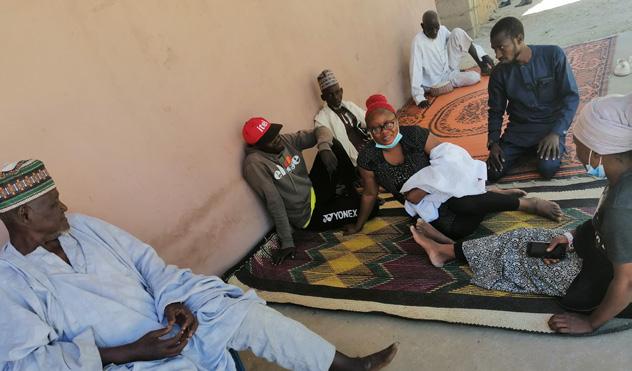
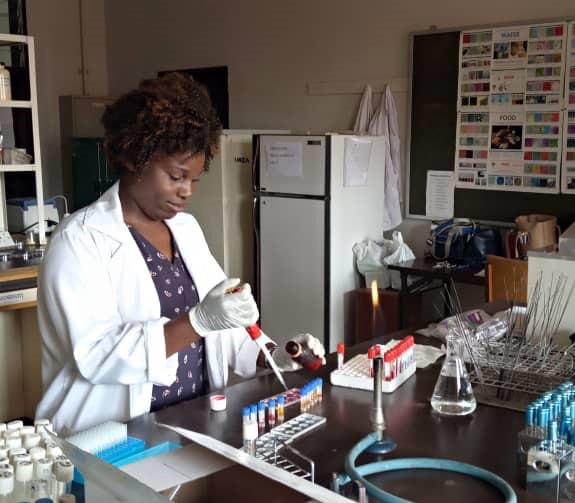
Ms Gaby Monteiro, Mozambique. Cell culture inspection of the flasks for cell monolayer confluency. Ms Iqra Sarfaz, Pakistan. Microscopic observation with lab fellow Farzana Sharif for the identification of histopathological alterations in mouse tissues for toxicological evaluation of PKM2 inhibitors .

versity and population structure of this vulnerable plant species is important for assessing extinction risk, setting up conservation plans and use in sustainable global development. Therefore, the objective of this project is to understand the linkage between phytochemical and genetic variation, screen phytochemically potent germplasm, investigate anticancer activity, and develop a protocol for in vitro propagation.
MS IQRA SARFRAZ, PAKISTAN
Transforming fruit waste biomass into health dietary supplements for cancer treatment
The development of cancer-specific therapeutics has been limited because most healthy cells and cancer cells depend on common pathways. Recent evidence suggests that targeting cancer metabolism may offer selectivity in cancer treatment. Thus, therapies targeting novel modes of action are greatly needed. Targeting tumour metabolism may offer a selective and effective anti-cancer therapy because metabolic enzymes could be easier targets as correlated to signaling proteins and transcription factors. It may be likely to identify inhibitors to achieve broad therapeutic windows for the treatment of cancer as correlated to conventional chemo-therapies. A promising novel anticancer drug target is Pyruvate Kinase M2 (PKM2), which predominantly overexpresses in a number of tumour types, and its inhibition results in decreased tumour growth and metastasis. Therefore, the aim of this project is to identify potent inhibitors of PKM2 from fruit waste biomass, prepare the enriched extracts of PKM2 inhibitors by using green chemistry approaches, and demonstrate their therapeutic value for cancer treatment. These enriched extracts of PKM2 inhibitors with other therapeutic drug combinations will counteract drug resistance and maximise clinical efficacy. This drug discovery approach represents a paradigm shift to develop new therapeutics, ultimately addressing concerns of cost, toxicity, non-selectivity and resistance of available chemo drugs, which have restricted their widespread application and efficacy.
DR RUTH LINDIZYANI MFUNE, ZAMBIA
Characterisation of human and bovine Brucella species in Southern and Western Provinces of Zambia
Brucellosis is an infectious zoonotic disease that affects humans, domestic livestock and wildlife, ranking 10th among diseases that impact poor people. In Zambia, brucellosis is prevalent in traditional cattle in Southern (14-22%) and Western (17.9-22.18%) Provinces as well as in humans (5.03%). There is scarce information on which Brucella species and strains are circulating in humans and animals in Zambia because most of the studies have focused more
on seroprevalence in cattle and wildlife than humans. The study will estimate seroprevalence, undertake phenotypic and genotypic characterisation of the Brucella isolates from humans and cattle, compare the isolates’ genetic relatedness, and evaluate the antimicrobial susceptibility status of the human isolates to the WHO-recommended antibiotics for treatment of brucellosis. At the end of this study, the Brucella species and biovars circulating in Zambia will be identified, and their genotypic relationship with those existing in the region and internationally will be known.
DR OLUWAREMILEKUN AJAKAYE, NIGERIA
Molecular investigation of hybridisation between livestock and human schistosomes parasites in wetlands used by pastoralists in Nigeria
Nigeria has the highest prevalence of the neglected tropical disease schistosomiasis, caused by Schistosoma species of parasitic worms. Reports of hybrid human-livestock Schistosoma species infecting patients have increased interest in schistosomiasis research. The evolution of Schistosoma hybrids is of public health concern due to its potentially significant impact on diagnosis, degree of virulence, drug resistance and host specificity. Different factors such as climatic change, increasing demand for water and increased animal production have resulted in the sharing of water bodies by both livestock and humans and this practice has been incriminated in the evolution of Schistosoma hybrids. Pastoral wetlands are ideal foci for hybridisation of schistosome parasites in Nigeria due to increasing usage of wetlands as water sources for both humans and livestock during the dry seasons characterised by a shortage of food. The WHO’s goal to eliminate schistosomiasis as a public health problem in multiple countries in Africa by 2020, and globally by 2025, can be hampered by significant gaps in epidemiological data. For the first time in Nigeria, this study will use DNA sequencing techniques to investigate the occurrence and transmission dynamics of hybrid Schistosoma species among pastoralists, their livestock, intermediate snail hosts and environmental DNA in wetlands in Nigeria. It is expected that this study will provide an insight into the molecular epidemiology of hybrid Schistosoma parasites in Nigeria.
MS MULEMBA SAMUTELA, ZAMBIA
Carriage and characterisation of Staphylococcus aureus from pigs and humans in Lusaka Province of Zambia
Staphylococcus aureus is a commensal opportunistic pathogen present in both healthy and diseased humans and animals. It causes several diseases including pneumonia, septicemia, and skin and soft tissue infections. Its medical importance has been heightened by the emergence of resistance to antibiotics resulting in methicillin-resistant Staphylococcus aureus (MRSA). MRSA is among the important causes of hospital- and community-acquired infections worldwide. Recently, MRSA emerged among livestock and has been described as Livestock-associated-MRSA (LA-MRSA). Studies of LA-MRSA have shown that it is prevalent in a wide range of animal species and significantly colonises and causes infection in farmworkers and other individuals with professional contact with livestock. These persons are presumably the source of LA-MRSA transmission to household members and their associates. However, there is sparse information about LA-MRSA strains circulating in African countries, including Zambia. Therefore, this study will determine the phenotypic and genotypic characteristics of Staphylococcus aureus isolated from pigs, farmworkers and other high-risk individuals in Lusaka Province. The results of this study will give an insight into the epidemiology of S. aureus in pigs and high-risk individuals. This will make it possible to trace the zoonotic potential of S. aureus (including MRSA) among these individuals, thereby strengthening the control and prevention strategies of S. aureus infections in Zambia.
MS GABY MONTEIRO, MOZAMBIQUE
Development and validation of a novel virus neutralisation test for Rift Valley Fever diagnoses
Zoonotic vector-borne diseases such as Dengue, Chikungunya and Rift Valley Fever (RVF) have emerged in Mozambique, related to deforestation, intense globalisation, unplanned urbanisation and global warming. This project focuses on RVF Virus (RVFV), a neglected infectious disease in Africa. The real threat posed by RVFV, coupled with the fact that there are no effective licensed vaccines for human use, clearly illustrate the need for more RVFV diagnosis and vaccine research. This project will study the potential of an attenuated virus as an alternative resource for Serum Neutralisation Test, the gold standard test for RVFV confirmation diagnoses. The classical VNTs make use of a virulent RVFV and therefore have to be performed in BSL-3 laboratories. This project will develop a novel VNT that is based on the attenuated recombinant RVFV. This novel test can be performed in a BSL-2 laboratory, making it suitable for other virology laboratories in Mozambique and Sub-Saharan Africa. The results from this project will contribute to building capacity in diagnosis and consequently increase our preparedness for prevention and control of RVFV in the event of an outbreak. In addition, this study will open new perspectives for research on RVFV and other vectorborne diseases.
DR JULIUS MUGWERU, KENYA
Population genetics of Honeybee (Apis mellifera), and the bacterial disease American Foulbrood in bee farming areas of Embu, Kenya
The rate of decline of honeybees is alarming given their vital role in the ecosystem. They are threatened by a myriad of diseases that are caused by bacteria, fungi or viruses. Among the bacterial pathogens, American Foulbrood (AFB) is the most pernicious bacterial disease of honeybees that results from the extreme persistence of the endospores of the causative agent Paenibacillus larvae. It exclusively infects the honeybee at the larval stage as early as 12 hours after hatching during capping. The honeybee larvae are infected when they are fed by nurse bees on feed that is contaminated with P. larvae spores. Although subtyping techniques and molecular characterisation have been used in differentiating the P. larvae strains, no efforts have been made to genotype the Paenibacillus larvae in Kenya. Within the P. larvae, four
genotypes have been identified using the Enterobacteriaceae repetitive intergenic consensus primers on the basis of repetitive element PCR designated as ERIC I-IV. These genotypes also show phenotypic differences that include their virulence. Kenyan bee farmers have reported a decline and collapse of bee colonies, but the cause is not clear. Furthermore, the abundance and distribution of bees, as well as their pathogens in Kenya, are yet to be mapped out. This information is important if remedial measures are to be developed to deter further population declines and avert potential food crises.
DR AGGREY GAMA, MALAWI
Integrating quinoa into the African diet
Quinoa has been recognised by the FAO as a useful crop in global efforts to eradicate hunger and malnutrition because of its high nutritive value and ability to adapt to different ecological and climatic conditions. As a result, quinoa has been introduced in Africa. In some African countries like Malawi, quinoa varieties have already been released, and yield is even much higher than that of maize. Therefore, incorporating quinoa into the diet of most Africans (maize-based stiff porridge) can help in achieving food and nutrition security. However, this could be possible only if the stiff porridge containing quinoa is acceptable. Therefore, this study will determine the extent to which quinoa flour can be incorporated into maize-based stiff porridge without compromising consumer acceptability. The study has the potential of promoting production and consumption of quinoa in Africa, which may eventually help in reducing prevalence rates of malnutrition in the region. The study will also provide more insights into the personality traits of consumers to guide appropriate food consumption-related promotional strategies, not just for quinoa but also many other food sources like bio-fortified crops.
DR STELLAH BYAKIKA, UGANDA
Starter culture development and improvement of safety of commercially produced Bongo, a fermented dairy product from Uganda Bongo is a traditional fermented drink from Uganda made by spontaneous fermentation of cow’s milk, responsible for its inconsistent quality and short shelf life. It is also noteworthy that some processors use un-boiled milk which also comprises consumer safety. Bongo, originally consumed in rural areas, is gaining popularity among urban dwellers. Consequently, there is increasing haphazard production of the product in Uganda. Moreover, the food safety regulatory agencies neither monitor its production nor have a relevant quality standard. Currently, literature on Bongo is limited, so a comprehensive study on evaluation and improvement of its quality is required. This study will examine the quality of commercially produced Bongo, by isolating, developing and preserving starter cultures for the product. Consequently, this research will contribute to improvement of the dairy sector in Uganda. There will be an upgrade in the quality of Bongo on the market and this will in turn generate more income for processors.
MS AMENAN FABIENNE N’ZI, CÔTE D’IVOIRE
Characterisation of Bacillus cereus group species isolated from artisanal infant flours in Côte d’Ivoire
To contribute to the safety of infant flours, WHO recommends foods of both nutritional and sanitary quality for breast-milk supplements. Because of their weak economic situations, populations resort to artisanal infant flours which generally have insufficiencies. Although efforts are increasingly being made to correct nutritional deficiencies, this is not always the case in terms of their health characteristics. Different pathogens and especially sporulating bacteria such as Bacillus cereus can be found in flours and cause harm to children. The aim of this project is to reduce the risk of Bacillus cereus food poisoning linked to the consumption of homemade infant flour in infants and young children in Côte d’Ivoire. To do so, an investigation will be conducted in three different towns to determine infant flour production systems as well as practices that promote contamination by B. cereus.
DR ROLI KAROLE TSATSOP TSAGUE, CAMEROON
Spray drying of indigenous fruit juices of Lannea microcarpa and Carissa edulis with carrier agents (carbohydrates, gums) of Cameroonian plants
Currently in the north Cameroon, the consumption of fruits of Lannea microcarpa and Carissa edulis has increased due to their nutritional and therapeutic value. However, there is a problem with spoilage of these seasonal indigenous fruits. Thus, value addition of the product by drying suggests a greater scope for elevating the utilisation of fruits and vegetables into development of quality products. This study will look for the best air-drying and spray-drying process conditions for the formulation of powders of L. microcarpa and C. edulis.




